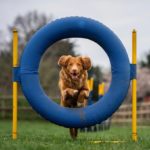From soaring over jumps, navigating around poles, and darting through tunnels – there’s simply no denying that dog agility courses are fast-paced, time-pressured, and sometimes complex to understand…especially if you’ve got four paws!
But, whether your dog is still a little bit too young to begin officially training, or you want to try out a few things at home before starting out expensive lessons, there are plenty of ways that you can train at home – and we’re here to lend a helping hand.

Below, we’re going to be talking you through some of the best ways that you can practice agility with your dog, and the best part? All of the tips and tricks that we’re going to be sharing with you can be done from the comfort of your very own home.
Plus, besides giving you an idea of what to expect from agility as a sport, trying out these agility tips will provide an opportunity for you and your dog to bond, while also helping your dog become more obedient, disciplined, and confident.
So, whenever you’re ready – just read on!
Tip #1: Make Sure That You’re Having Fun
Even though agility is a competitive sport, that doesn’t take away from the fact that it is something that is meant to be enjoyed – by both you and your dog.
That’s why, while you practice agility training at home with your dog, there should never be any pressure placed on your dog to perform skills perfectly, because the most important thing to keep in mind is that your dog should be having plenty of fun.
If you have a young dog that is currently too young to officially join classes or you just want to get a feel for agility prior to signing up, it’s imperative that you keep this at the forefront of your mind while you practice agility with your dog.
On one hand, you might discover that your dog enjoys agility and picks up skills fast, or you might find that your dog takes longer to learn skills than you expected and prefers to focus more time on playing.
Whatever the case might be, it’s important that you are taking the time to pay attention to how your dog is feeling, let go of any expectations that you might have, and focus on making sure that your dog is having a good time.
In addition to this, a big part of your dog’s enjoyment levels will come from plenty of encouragement from you.
If your dog successfully completes a skill or makes progress in one, then you should make sure that you are providing plenty of positive reinforcement so that your dog can know that they have done something good.
We also recommend that you try and keep your agility home training short and sweet, as your dog will likely lose interest after around 10 minutes.
Tip #2: Have Patience
Alongside making sure that you and your dog are having a good time, another hugely important aspect of home agility training is to ensure that you are giving your dog plenty of patience, especially when teaching new tricks and skills.
Besides making sure to use positive reinforcement and other types of positive encouragement, we also recommend that you are making sure to maintain a non-pressured teaching environment while agility training.
Remember, the main focus of agility is to have fun, so the last thing you want is to begin placing expectations on your dog to progress within a certain time frame.
Tip #3: Teach Your Dog Tricks Along The Way
Even though we’re sure that you’ll be keen to teach your dog a variety of agility skills as soon as you can, we also recommend that you consider teaching your dog basic tricks along the way, too.
Besides giving your dog variety (which will help to keep your dog focused during the training sessions) , taking the time to teach your dog tricks will help to increase your dog’s ability to pick up different agility skills.
Plus, it will also provide you with the opportunity to work on your teaching skills and hone your personal teaching techniques to discover what works best with your dog, and what doesn’t.
Typically, most dog owners that try this approach like to focus on tricks that help to develop their dog’s awareness of their body, as well as tricks that help to increase their dog’s ability to walk/run to different targets.
As an example, teaching your dog to move to a spot in your room or backyard after giving a visual cue and command will help your dog when you are both in the agility course, as your dog will be able to understand what part of the course they should be.
On the other hand, teaching your dog how to jump up, walk backward, and maneuver through obstacles will help your dog to become more agile and aware of its body.
As a side note, even if your dog doesn’t take to agility as a sport and you don’t end up taking it any further, taking the time to teach your dog new tricks and skills will increase your dog’s overall obedience, manners, flexibility, and concentration abilities.
Plus, in addition to all of that, spending time with your dog to teach agility tricks will also strengthen the bond that you both share, while also working to increase your dog’s confidence and trust levels felt for you.
Tip #4: Focus On Your Handling Abilities
Agility is a sport that requires you and your dog to work together as a team, so it’s important that you make sure that you’re being the best handler you can be.
Even though your dog will take center stage while out on the course, how well your dog performs will ultimately depend on how well you are able to handle your dog and provide clear commands and instructions for the entirety of the routine.
Tip #5: Increase Your Dog’s Confidence
Last but not least, one of the most important things that you will need to do while practicing agility at home, is to work on raising your dog’s confidence level.
First things first, we recommend that you introduce moving apparatus in your training sessions (when you feel the time is appropriate) so that your dog can begin to get a feel for what the moving seesaw will be like.
Even though classes will provide proper training, taking the time to help your dog get used to moving apparatus in an environment that your dog is comfortable with will help your dog to get over any fears associated with the seesaw.
Alongside that, we also recommend that you slowly introduce your dog to the tunnel from home, as being exposed to new apparatus in an environment that is familiar will help to ensure that your dog does not become anxious or scared.
If you do not have a tunnel, you could create a makeshift one with a big cardboard box (or something similar). It’s very important that you don’t force your dog to walk through the makeshift tunnel, as this could cause your dog to become frightened.
Instead, we recommend allowing your dog to explore the tunnel in his own time – you could even crawl through the tunnel or place a treat near the entrance.
- 8 Signs That Your Dog Is In Heat - November 8, 2022
- Why Is My Dog Whining Whilst Carrying A Toy In Their Mouth? - August 17, 2022
- Reasons Why Your Dog’s Poop Is White And What To Do About It - August 17, 2022









